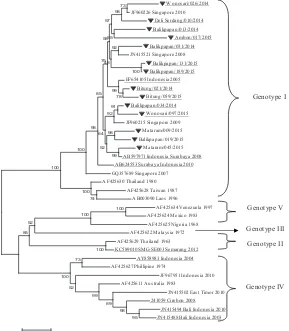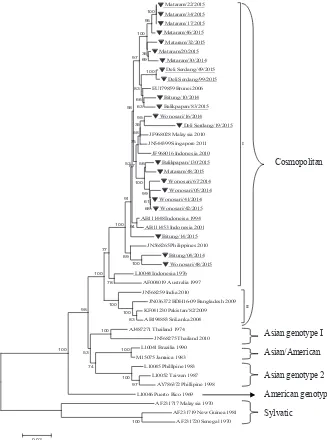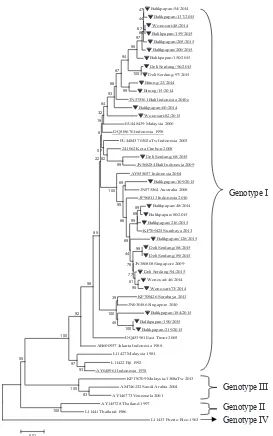Genotypes of dengue virus circulate in dengue sentinel surveillance in Indonesia
Reni Herman, Hartanti Dian Ikawati, Arie Ardiansyah Nugraha, Agustiningsih, Masri Maha Sembiring
Center for Research and Development of Biomedical and Basic Health Technology, National Institute of Health Research and Development, Ministry of Health, Jakarta, Indonesia.
Corresponding address: Dr. dr. Reni Herman, M.Biomed Email: [email protected]
Received: Agustus 05, 2016; Revised: November 10, 2016; Accepted: November 24, 2016
Abstrak
Latar Belakang: Demam berdarah dengue disebabkan oleh infeksi virus dengue (DENV) yang terdiri atas serotipe 1 sampai dengan serotipe 4. Masing-masing serotipe dibedakan lagi menjadi beberapa genotipe. Studi ini dilakukan untuk mendeteksi genotipe DENV yang bersirkulasi di lokasi surveilans sentinel dengue.
Metode: Untuk menentukan genotipe dilakukan analisis genetik menggunakan perangkat bioinformatik. Urutan nukleotida yang lengkap dari gen selubung DENV diperoleh melalui amplifikasi genetik menggunakan primer overlapping untuk masing-masing serotipe. Pohon filogenetik dibuat menggunakan perangkat lunak MEGA 6.0, metode Neighbor Joining dengan 1000 replikasi dan parameter Kimura-2. Sekuen nukleotida dari GenBank yang telah diketahui genotype DENV digunakan sebagai referen.
Hasil: Jumlah sampel dengan gen selubung DENV yang dapat diamplifikasi adalah 64 dari 204 kasus yang
terkonfirmasi. Empat belas sekuen dari DENV-1, 22 sekuen DENV-2, dan 28 sekuens DENV-3. Dari studi ini belum didapatkan sekuen untuk DENV-4. DENV-1 dan DENV-2 masing-masing masuk dalam kelompok genotipe I dan Cosmopolitan, sementara DENV-3 masuk dalam kelompok genotipe I.
Kesimpulan: Genotipe DENV di lokasi surveilans sentinel dengue sama dengan genotype yang sebelumnya dilaporkan bersirkulasi di Indonesia. (Health Science Journal of Indonesia 2016;7(2):69-74)
Kata kunci: surveilans sentinel dengue, virus dengue, genotype
Abstract
Background: Dengue hemorrhagic fever was caused by dengue virus (DENV). This virus has four serotypes, DENV-1 to DENV-4, in which each serotype consists of various genotypes. This study present the distribution of DENV genotype circulate in dengue sentinel surveillance sites.
Methods: We performed molecular analyses using bioinformatics tools to identify genotype of DENV. Sequencing targeting envelope gene was carried out on DENV-positive samples. Full-length sequence of envelope gene was obtained using overlapping primers for DENV 1, 2, 3 and 4. Phylogenetic tree was generated by Neighbor Joining using MEGA 6.0 with 1000 bootstrap replications and Kimura 2-parameter model. Known genotype of DENV sequences from Indonesia and other countries obtained from GenBank were included in the analyses as references.
Results: A total of 64 complete coding sequences of envelope gene from DENV-1, DENV-2 and DENV-3 were successfully sequenced from 204 confirmed DENV cases. There are fourteen sequences of DENV-1, 22 sequences of DENV-2 and 28 sequences of DENV-3. Unfortunately, there was no complete coding sequence of envelope gene obtained for DENV-4. DENV-1 and DENV-2 were grouped into genotype I and cosmopolitan genotype, respectively. The DENV-3 was grouped into genotype I. These viruses were belongs to various genotypes that have been circulating previously in Indonesia.
Conclusion: This finding suggests that the distribution of DENV genotype in sentinel sites remained stable. (Health Science Journal of Indonesia 2016;7(2):69-74)
Dengue virus (DENV) is the causative agent of dengue infection. DENV belongs to family Flaviviridae and genus Flavivirus. DENV serotypes have four genetically and antigenically different, known as 1, DENV-2, DENV-3 dan DENV-4. Each serotype is divided into several genotypes based on the sequence variability on the envelope gene (E gene). DENV-1 consists of five genotypes (genotype I-V).1 DENV-2 comprises of American genotype, Cosmopolitan, Asian I, Asian II, American Asian genotype and Sylvatic.2 DENV-3 consists of 4 genotypes (genotype I-IV)3 and DENV-4 comprises of 4 genotypes (genotype I-III and sylvatic ).4
Genotyping of DENV is essential as the identification of DENV genotype could provide information of genetic changes in DENV gene, and to detect the introduction of new genotype in certain area. In addition, DENV as RNA virus continues to evolve and the identification of DENV genotype could provide crucial information of the dynamic change of DENV.5
It was reported that genotype I and IV of DENV-1 circulated in Indonesia.6 So are cosmopolitan of 2, genotype I of 3 and genotype II of DENV-4.7,8 Therefore limited data was available regarding the distribution of DENV genotype in dengue sentinel surveillance sites, which serum samples were sent to National Institute of Health Research and Development (NIHRD). The surveillance was conducted to obtain information on epidemiology and virology of DENV and other arboviruses. In this study we present the distribution of DENV genotype circulate in dengue sentinel surveillance sites.
METHODS
Samples and DNA sequencing
DENV-confirmed samples were obtained from dengue cases of dengue sentinel surveillance systems sites in Deli Serdang (North Sumatra), Wonosari (Jogjakarta), Balikpapan (East Kalimantan), Bitung (North Sulawesi), Ambon (Maluku) and Mataram (West Nusa Tenggara) from September 2014 to December 2015. (Figure.1)
DENV E gene could be amplified from the sera of some samples, however for some other samples DENV should be isolated and propagated on cell culture. The archived clinical specimens that confirmed as DENV positive were cultured in Vero
76 cell line. The supernatant of Vero 76 cell line was collected from cell line showed cytopathic effect (CPE) followed by the viral RNA isolation using QiAmp Viral Mini Kit (Qiagen, Hilden, Germany) according manufacturer’s instruction. The complete coding sequence of envelope gene was derived using overlapping primer of DENV 1, 2, 3, and 4 9 with some
modifications. Direct DNA sequencing was carried out using the Big Dye Terminator V.3.0 Cycle Sequencing Ready Reaction Kit (Applied Biosystems, Foster City, CA) on ABI 3130 x l Genetic Analyzer automatic sequencer (Applied Biosystems, Foster City, CA, USA).
Genotype analysis
The overlapping nucleotide sequences were edited, assembled and aligned using BioEdit Sequence Alignment Editor Ver 7.0.5.2 . Multiple alignment of DENV envelope gene sequences (1485 nt for DENV-1 and DENV-2, DENV-1479 nt for DENV-3) was performed by ClustalW using MEGA 6.0.10 Then phylogenetic tree was generated by Neighbor Joining using the same software with 1000 bootstrap replicates and Kimura 2-parameter model. Existing genotype of DENV sequences from Indonesia and other countries obtained from GenBank were included in the analyses as references. Classifications scheme of genotype utilized as proposed by previous publications.1-4
The study got ethical approval from National Institute of Health Reseach and development ethical committee No. LB.02.01/5.2/KE. 208/2015.
RESULTS
During study period, 204 samples were DENV positive out of 585 specimens sent to NIHRD. All DENV serotypes, DENV-1 to DENV-4 were found from all of sentinels in which DENV-3 was the dominant serotypes.
sites. The phylogenetic tree illustrated in Figure 2, shows that DENV-1 circulated in sentinel sites formed a cluster with those detected in Singapore 2007-2010. Nucleotide sequence identity between clades ranged from 97%-99%.
There were 22 samples that successfully sequenced for envelope gene of DENV-2. All sequences were grouped in cosmopolitan genotype. These sera
samples came from all of sentinel site except Ambon. The DENV-2 phylogenetic tree illustrated in Figure 3, showed that the Indonesian Cosmopolitan genotype were closely related to isolates that circulated previously in Indonesia7,11 also in neighboring country such as Brunei in 2006, Malaysia and Philippines in 2010, and Singapore in 2011. Homology sequences within clade were 97% -100%. This phylogenetic tree also showed that Indonesian Cosmopolitan belong to first sub-lineage. (Figure 3).
Figure 1.Map of Indonesia archipelago. The red bullet indicates the sentinel sites
Figure 2. Phylogenetic Tree of DENV-1 constructed based on envelope gene (1485 nt). The Indonesian sequences were shown in underline, our sequence marked by red solid triangle (▼). Known strains as references from GenBank were d noted by accession number, country and year of isolation. Genotypes are also indicated by reference sequence, classification scheme as proposed by Goncalvez, et al 2002.
▼
Wonos ari/026/2014 JF960226 Singapore 2010
Deli Serdang/010/2014 Balikpapan/013/2014
Ambon/017/2015 Balikpapan/031/2014 JN415521 Singapore 2008
Balikpapan/131/2015 Balikpapan/189/2015 EF654105 Indonesia 2005
Bitung/021/2014 Bitung/059/2015 Balikpapan/034/2014
Wonosari/097/2015 JF960215 Singapore 2009
Mataram/009/2015 Balikpapan/019/2015
Mataram/045/2015 AB597971 Indones ia Surabaya 2008 AB624553 Surabaya Indones ia 2010 GQ357689 Singapore 2007 AF425630 Thailand 1980
AF425628 Taiwan 1987 AB003090 Laos 1996
AF425634 Venezuela 1997 AF425624 Mexico 1983 AF425625 Nigeria 1968 AF425622 Malaysia 1972 AF425629 Thailand 1963 KC589010 SMG-SE003 Semarang 2012
AY858983 Indonesia 2004 AF425627 Phillipine 1974
JF967951 Indones ia 2010 AF425611 Aus tralia 1983
JN415502 East Timor 2010 241059 Cirebon 2008
JN415494 Bali Indonesia 2010 JN415488 Bali Indonesia 2003
100
95 98 100
89 100
99 73
52 100 52
85
74 100 100
100
100
73
99 78 98
91 99
98 92 92
98
52 64 85
55 57
75 48 58
0.01
Genotype I
Genotype V
Genotype III
Genotype II
Figure 3. Phylogenetic tree of DENV-2 constructed based on envelope gene (1485 nt). The Indonesian sequences are designated with underline and sequences from dengue sentinel sites marked with solid triangle (▼). Strains from GenBank as references were denoted by accession number, country and year of isolation. Genotypes are also indicated by reference sequence, classification scheme as proposed by Twiddy et al 2002. Two Cosmopolitan sub-lineage indicated by I and II.
In addition, 28 sequences of DENV-3 were grouped in genotype I. (Figure. 4). The Origin of DENV-3 sequences found in this report were from Deli Serdang, Wonosari, Balikpapan and Bitung. Phylogenetic tree of DENV-3 showed that genotype I of DENV-3 circulated in sentinel sites were closely related to Malaysia 2006, Singapore 2009-2010 and Australia in 2008. These sequences showed more than 97% nucleotide homology. Phylogenetic tree analysis showed that DENV-3 circulated in sentinel sites had same ancestor.
DISCUSSIONS
This surveillance conducted in six district hospital located in six different islands which enable us to have representation of each region in Indonesian archipelago. It represented east (Maluku), central (East Kalimantan, North Sulawesi and West Nusa Tenggara) and west (Yogyakarta and North Sumatra) part of Indonesia. In this study the samples were collected from September 2014 to December 2015.
▼ EU179859 Brunei 2006
Bitung/10/2014 Balikpapan/83/2015 Wonosari/16/2014
Deli Serdang/19/2015 JF968028 Malaysia 2010 JN544399 Singapore 2011
JF968016 Indonesia 2010 Balikpapan/130/2015 AB111448 Indoneisa 1994
AB111453 Indonesia 2001 Bitung/14/2015 JN568265 Philippines 2010
Bitung/04/2014 Wonosari/48/2015 L10044 Indonesia 1976
AF004019 Australia 1997
I
JN568259 India 2010
JN036372 BDH16-09 Bangladesh 2009 KF041230 Pakistan/82/2009 AB194883 SriLanka 2004
II
AJ487271 Thailand 1974 JN568275 Thailand 2010 L10041 Brazilia 1990 M15075 Jamaica 1983 L10045 Philllpine 1983
L10052 Taiwan 1987 AY786372 Phillipine 1998 L10046 Puerto Rico 1969
AF231717 Malaysia 1970 AF231719 New Guinea 1981
AF231720 Senegal 1970
100
Asian genotype 2
American genotype
Sylvatic Asian genotype I
Figure 4. Phylogenetic Tree of DENV-3 constructed based on envelope gene (1479 nt). The Indonesian sequences were shown with undeline. The sequences from dengue sentinel sites marked with solid triangle (▼). Sequences for reference from GenBank were denoted by accession number, country and year of isolation. Genotypes are also indicated by reference sequence, classification scheme as proposed by Lanciotti et al 1994.
It was reported by Sjatha et.al (2012) that two genotypes of DENV-1 predominantly circulated in Indonesia, the genotype I and IV. The genotype IV of DENV-1 has been indigenous in Indonesia since 1948. It was likely to spread over the region and into the Indian Ocean countries and predicted diverged frequently around
1967.6 In Surabaya, another city in which endemic
of dengue, genotype of the DENV-1 was reported to shift from genotype IV to I in 2010.12 The genotype I circulated in the sentinel sites, and it have been circulated in Medan and Bandung in 2008 (data not shown), but another report suggesting that this genotype has been circulated in Indonesia since 2005.13 A recent study in Semarang has reported DENV-1 genotype II that was
the old genotype circulated in Indonesia,8 we did not
find the genotype II in this study.
The Cosmopolitan genotype of DENV-2 has a wide geographical distribution including strains from Southeast Asia, Australia, India, China and the Middle East.14 Based on previous data, the Cosmopolitan genotype was separated into two geographically different sub-lineages. One sub-lineage observed in Southeast Asia, China and Oceania, other was observed in the India subcontinent.15 The Cosmopolitan genotype circulated in sentinel sites found in this study, was similar with the first sub-lineage.
▼ JN575561 Bali Indonesia 2010c
Balikpapan/60/2014 Wonosari/82/2015 EU448439 Malaysia 2006 DQ518676 Indonesia 1998
EU448437 0302aTw Indonesia 2003 241062 Kota Cirebon 2008
Deli Serdang/68/2015 JN568284 Bali Indonesia 2009 AY858037 Indonesia 2004
Balikpapan/109/2015 JN575564 Australia 2008 JF968113 Indonesia 2010 Balikpapan/48/2014 Balikpapan/80/2015 Balikpapan/216/2015 KF709425 Surabaya 2013
Balikpapan/128/2015 Deli Serdang/88/2015 Deli Serdang/89/2015 JN380808 Singapore 2009
Deli Serdang/94/2015 Wonosari/46/2014
Wonosari/73/2014 KF709426 Surabaya 2013 JN030186 Singapore 2010
Balikpapan/184/2015 Balikpapan/190/2015
Balikpapan/219/2015 DQ453981 East Timor 2005 AB600937 Jakarta Indonesia 1988
L11427 Malaysia 1981 L11422 Fiji 1992 AY648961 Indonesia 1978
KP176709 Malaysia/1308aTw 2013 AM746232 Saudi Arabia 2004 AY146773 Venezuela 2001 AY145728 Thailand 1997 L11441 Thailand 1986
L11433 Puerto Rico 1963
DENV-3 is the most dominant serotypes found in this study and was grouped as genotype I. There were two sub-lineages of DENV-3 circulated in Indonesia that isolated before and after 1998, DENV-3 isolated after 1998 had gave greater impact on DHF epidemic.16 We found that all DENV-3 sequences from sentinel sites had close related to DENV-3 isolated after 1998. Other author have observed the existence of some intragenotypic groups that reveal amino acid changes in the envelope gene of DENV-3.17 Since DENV-3 had significantly higher nucleotide substitution rate and may potentially cause endemic outbreak,5 further study are needed to monitoring the spread of this virus in Indonesia.
Although this serotype was found in this study we are unable to obtain any DENV-4 sequences. To deal with this problem, in the future we could apply methods that utilize shorter fragments of E gene to determine the genotype of our DENV-4.
Laboratory-based dengue surveillance system in Indonesia has just initiated in late 2014 and still ongoing. Prior to that, samples from dengue cases were not collected continuously in sentinel system. Therefore we could not find comprehensive epidemiology and virology data from the related sentinel with consecutive years, the authors aware that many studies and incidental survey concerning dengue were carried out previously. Essential data was generated and dengue sequence could be obtained from public domain such as Genbank. However, continuous surveillance would be useful to understand the dynamic of dengue disease in Indonesia. Even though, some of the information about DENV genotype in Indonesia still can be found in some publication and also in Gene Bank.
In conclusion, we have presented the distribution of DENV genotype in dengue sentinel surveillance sites. These viruses were belongs to various genotypes that have been circulating previously in Indonesia.
Acknowledgments
We would like to thank to NIHRD, Ministry of Health
Indonesia for study funding. We thank to Health district
officers, Hospitals, Vector Borne Diseases Control in Deli Serdang, Wonosari, Balikpapan, Bitung, Ambon and Mataram. We thank also to Subdirectorate of Arbovirosis - Directorate of VBDC, Directorate General for Disease Prevention and Control at The Ministry of Health Indonesia.
REFERENCES
1. Goncalvez AP, Escalante AA, Pujol FH, et al. Diversity and evolution of the envelope gene of dengue virus type 1. Virology 2002; 303(1): 110-9.
2. Twiddy SS, Farrar JJ, Vinh Chau N, et al. Phylogenetic relationships and differential selec tion pressures among genotypes of dengue-2 virus. Virology 2002; 298(1): 63-72. 3. Lanciotti RS, Lewis JG, Gubler DJ, et al. Molecular
evolution and epidemiology of dengue-3 viruses. J Gen Virol 1994; 75 ( Pt 1): 65-75.
4. Lanciotti RS, Gubler DJ, Trent DW. Molecular evolution and phylogeny of dengue-4 viruses. J Gen Virol 1997; 78 ( Pt 9): 2279-84.
5. Kotaki T, Yamanaka A, Mulyatno KC, et al. Phylogenetic Analysis of Dengue Virus Type 3 Strains Primarily Isolated in 2013 from Surabaya, Indonesia. Japanese Journal of Infectious Diseases 2014; 67(3): 227-9. 6. Sjatha F, Takizawa Y, Yamanaka A, et al. Phylogenetic
analysis of dengue virus types 1 and 3 isolated in Jakarta, Indonesia in 1988. Infect Genet Evol 2012; 12(8): 1938-43. 7. Nusa R, Prasetyowati H, Meutiawati F, et al. Molecular
surveillance of Dengue in Sukabumi, West Java province, Indonesia. J Infect Dev Ctries 2014; 8(6): 733-41. 8. Fahri S, Yohan B, Trimarsanto H, et al. Molecular
surveillance of dengue in Semarang, Indonesia revealed the circulation of an old genotype of dengue virus serotype-1. PLoS Negl Trop Dis 2013; 7(8): e2354. 9. Schreiber MJ, Harun S, Chen YL, et al. Characterization
and sequencing of isolates from the 2004 Indonesian dengue outbreak. 2009. Unpublish.
10. Tamura K, Stecher G, Peterson D, et al. MEGA6: Molecular Evolutionary Genetics Analysis version 6.0. Mol Biol Evol 2013; 30(12): 2725-9.
11. Ong SH, Yip JT, Chen YL, et al. Periodic re-emergence of endemic strains with strong epidemic potential-a proposed explanation for the 2004 Indonesian dengue epidemic. Infect Genet Evol 2008; 8(2): 191-204. 12. Yamanaka A, Mulyatno KC, Susilowati H, et al.
Displacement of the predominant dengue virus from type 2 to type 1 with a subsequent genotype shift from IV to I in Surabaya, Indonesia 2008-2010. PLoS One 2011; 6(11): e27322.
13. Jeong YE, Kim YH, Cho JE, et al. Identification of Dengue Type 1 Virus (DENV-1) in Koreans Traveling Abroad. Osong Public Health and Research Perspectives 2011; 2(1): 34-40.
14. Huang JH, Su CL, Yang CF, et al. Molecular characterization and phylogenetic analysis of dengue viruses imported into Taiwan during 2008-2010. Am J Trop Med Hyg 2012; 87(2): 349-58.
15. Khan MA, Ellis EM, Tissera HA, et al. Emergence and diversification of dengue 2 cosmopolitan genotype in Pakistan, 2011. PLoS One 2013; 8(3): e56391.
16. King C-C, Chao D-Y, Chien L-J, et al. Comparative analysis of full genomic sequences among different genotypes of dengue virus type 3. Virology Journal 2008; 5(1): 63.


